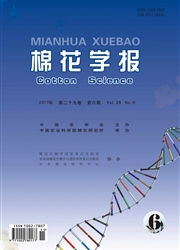

 中文摘要:
中文摘要:
以陆地棉抗黄萎病品系常96和感病品种军棉1号为研究材料,构建了一个含有138个F2单株的作图群体。利用强致病力菌株VD8对P1、P2、F1、F2:3群体进行营养钵接种,估算各世代的相对病指。应用主基因-多基因混合遗传模型分析得出该组合的最适遗传模型为C-0模型,即加性-显性-上位性多基因模型。对1998对SSR引物和230对SRAP引物进行筛选,获得148个SSR和6个SRAP多态性标记位点,进一步利用MAPMAKER作图软件,构建了一张含122个标记位点的陆陆杂种遗传连锁图。利用复合区间作图法在第9染色体NAU462-JESPR114区间内,检测到1个抗黄萎病QTL,可解释的表型变异为13.8%。
 英文摘要:
英文摘要:
Molecular marker-assisted selection was eft ecUve to qutckly breeding cultivars resistant to Verticillium wilt. In this research, the upland cotton strain Chang 96, which is resistant against Verticilliurn wilt, and the susceptible variety, Junmian 1, were used as experimental materials, a tagging population with 138 F2 individual plants was developed. By artificially inoculating the strongly pathogenic fungi strain to the populations P1, P2, F2,3, F2.3, the relative disease indexes of each generation was estimated. Using the method of the major gene plus polygene mixed genetic model analysis between maior gene and multiple genes, the optimum genetic model of that combination was discovered to be C-0 model, i. e. , the multiple gene model among additiveominant-epistatic genes. A total of 1998 pairs of SSR primers, and 230 pairs of SRAP primers were screened, 148 SSR and 6 SRAP polymorphism marker loci were obtained. Furthermore, by utilizing Mapmaker software, a genetic linkage map based on intraspecific F2 populations with 122 marker loci was constructed. According to the composite interval principle to scan total cotton genome by Mapmaker/QTL program, one resistance QTL was detected and localized on chromosome nine between the interval of the NAU462 and JESPR114, 13.8% phenotypic variance in F2,3 of which might be explained.
 同期刊论文项目
同期刊论文项目
 同项目期刊论文
同项目期刊论文
 期刊信息
期刊信息
